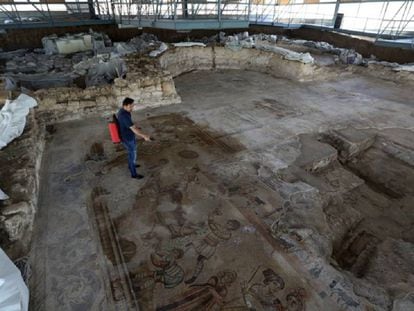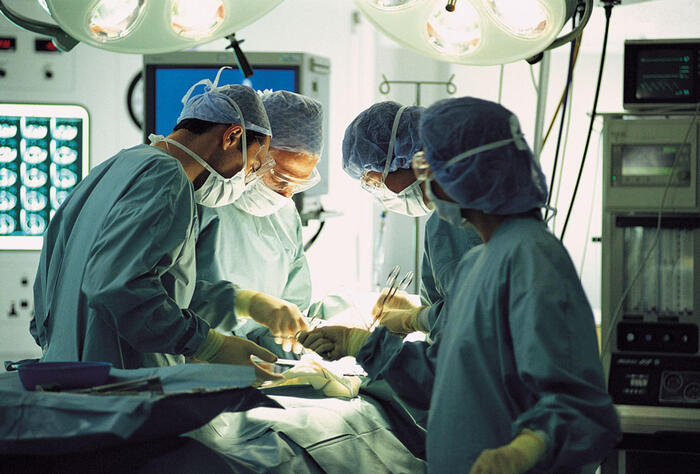On July 5, 1968, the archaeologist Javier Cortés Álvarez de Miranda made a spectacular discovery on his property in Pedrosa de la Vega (Palencia): a Roman villa of 4,400 square meters with 35 rooms, of which 26 had pavements of mosaic.
It is known as the Roman villa of La Olmeda, an impressive and sumptuous building, owned by a great lord or
dominus , a perfect place for the
hydraulis
to sound inside ,
a Roman organ that is considered the first keyboard in history.
This Tuesday, the Diputación de Palencia, owner of the site, presented in Madrid a replica of that instrument reproduced from historical documentation and written testimonies of the Emperor Nero (not only did he like the lyre and singing), Cicero or Quintiliano.
The National Archaeological Museum has been the site chosen for the tubes of that mechanical device to vibrate again after 2,250 years.
More information
The most luxurious villa in Roman Hispania shows its treasures
The
hydraulis
was an organ with a mechanism that combined water and air with which a wind was created that fed its pipes.
It was used in theaters, amphitheaters and circuses, as well as in social or liturgical gatherings held in public or private places.
To own one, you had to be very rich, as reflected in the sumptuousness of the Palencia town.
The presented replica has been made by the craft workshop Acitores.
The drafters of the project affirm that the
tetrachord hydraulis
(that is, armed with four rows of tubes) produced 18 diatonic notes and was suitable for large musical performances.
Nero's lyre, no.
In fact, the Diputación de Palencia is going to train musicians to manage it with the aim of programming concerts and educational talks.
A team of designers, carpenters, mechanics, pipe makers and harmonica players, who work in a workshop in Torquemada (Palencia), have built more than one hundred organs in recent years ―mainly destined for the international market― and recovered another hundred historic ones, including those of the cathedrals of Córdoba and Logroño, in addition to that of the church of Los Clérigos, in Oporto (Portugal).
This prestigious professional team was chosen by the Diputación Palencia to recreate the
Hydraulis
de la Olmeda.
Francisco Acitores, responsible for the recreation, explained "that it has been quite a challenge, because there were no models to imitate and it was necessary to build a puzzle with the data and the existing archaeological remains to make it sound".
the
hydraulics,
According to ancient texts, it was invented by a Greek engineer named Ctesibius of Alexandria 250 years before the birth of Christ.
Numerous Greco-Latin writers and philosophers, such as Philo of Byzantium, Aristotle, Pliny, Suetonius and Tertullian, reported his invention.
The instrument is even mentioned in much later works by San Isidoro de Sevilla and Alfonso X el Sabio.
In addition, some loose pieces have been preserved at the Pompeii site, as well as others that were found in 1931 in excavations in Budapest, in 1992 in Delphi (Greece) and in 1996 in Switzerland.
Its interior mechanism is known from the drawings of the Roman treatise writer Vitruvius (1st century) and its exterior from the multiple representations that exist of it on coins and terracotta lamps, but above all the numerous mosaics where it was represented.
hydraulics
of 28 tubes.
The visitable Roman villa of La Olmeda, declared a Site of Cultural Interest in 1996 (the maximum possible heritage protection), corresponds to an impressive rural mansion of the late Empire (4th century) that has one of the best Roman mosaic collections in the world: About a thousand and a half square meters of polychrome mosaics preserved
in situ.
In Saldaña, a town located about six kilometers away, a museum completes the vision of life in late-imperial Rome with the exhibition of the objects that appeared among the ruins: coins,
terra sigillata
(or luxury) crockery, tools, trappings and funerary ceramics.
The main building – actually the villas are huge agri-food and leisure complexes – is made up of two parts (the house of the great lord itself and the bathing area), both joined by a corridor.
Everything is distributed, as befits this type of building, around a patio.
It was flanked by two square towers to the north and another two octagonal ones on the south façade.
Its great hall or
oecus
was decorated with figurative mosaics, as was the entrance, whose pavement reflects hunts, both on foot and on horseback, and where different animal species can be distinguished, such as lions or antelopes.
Other mosaics in the complex represent mythological scenes referring to the hero Achilles and even what are believed to be portraits related to the family of the
Segovian
emperor Theodosius the Great.
The baths, an outstanding part of a villa, include changing rooms, latrines, and hot, warm, and cold baths, all heated from the
propnigeum
, a kind of engine room and storehouse for the thermal complex.
Perhaps, after the bath, a good session of organ music would complete the party offered by the
dominus
of the town of Olmeda for the guests.
A more pleasant moment than listening to Nero and his lyre, although the contribution of this emperor has been essential to recover the oldest keyboard in the world in a municipality of Palencia.
50% off
Exclusive content for subscribers
read without limits
subscribe
I'm already a subscriber







